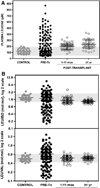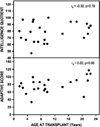Liver transplantation for classical maple syrup urine disease: long-term follow-up in 37 patients and comparative United Network for Organ Sharing experience
- PMID: 21839471
- PMCID: PMC3671923
- DOI: 10.1016/j.jpeds.2011.06.033
Liver transplantation for classical maple syrup urine disease: long-term follow-up in 37 patients and comparative United Network for Organ Sharing experience
Abstract
Objective: To assess clinical and neurocognitive function in children who have undergone liver transplantation for classical maple syrup urine disease (MSUD).
Study design: A total of 35 patients with classical MSUD (age 9.9 ± 7.9 years) underwent liver transplantation between 2004 and 2009. Six patients donated their liver to recipients without MSUD ("domino" transplant). We analyzed clinical outcomes for our cohort and 17 additional cases from the national United Network for Organ Sharing registry; 33 patients completed IQ and adaptive testing before transplantation, and 14 completed testing 1 year later.
Results: Patient and graft survival were 100% at 4.5 ± 2.2 years of follow-up. Liver function was normal in all patients. Branched-chain amino acid levels were corrected within hours after surgery and remained stable, with leucine tolerance increasing more than 10-fold. All domino transplant recipients were alive and well with normal branched-chain amino acid homeostasis at the time of this report. Patient and graft survival for all 54 patients with MSUD undergoing liver transplantation in the United States during this period were 98% and 96%, respectively. One-third of our patients were mentally impaired (IQ ≤ 70) before transplantation, with no statistically significant change 1 year later.
Conclusion: Liver transplantation is an effective long-term treatment for classical MSUD and may arrest brain damage, but will not reverse it.
Copyright © 2012 Mosby, Inc. All rights reserved.
Conflict of interest statement
The authors declare no conflicts of interest.
Figures




References
-
- Riviello JJ, Jr, Rezvani I, DiGeorge AM, Foley CM. Cerebral edema causing death in children with maple syrup urine disease. J Pediatr. 1991;119:42–45. - PubMed
-
- Simon E, Schwarz M, Wendel U. Social outcome in adults with maple syrup urine disease (MSUD) J Inherit Metab Dis. 2007;30:264. - PubMed
-
- Hoffmann B, Helbling C, Schadewaldt P, Wendel U. Impact of longitudinal plasma leucine levels on the intellectual outcome in patients with classic MSUD. Pediatr Res. 2006;59:17–20. - PubMed
-
- Simon E, Wendel U, Schadewaldt P. Maple syrup urine disease: treatment and outcome in patients of Turkish descent in Germany. Turk J Pediatr. 2005;47:8–13. - PubMed
Publication types
MeSH terms
Grants and funding
LinkOut - more resources
Full Text Sources
Other Literature Sources
Medical

